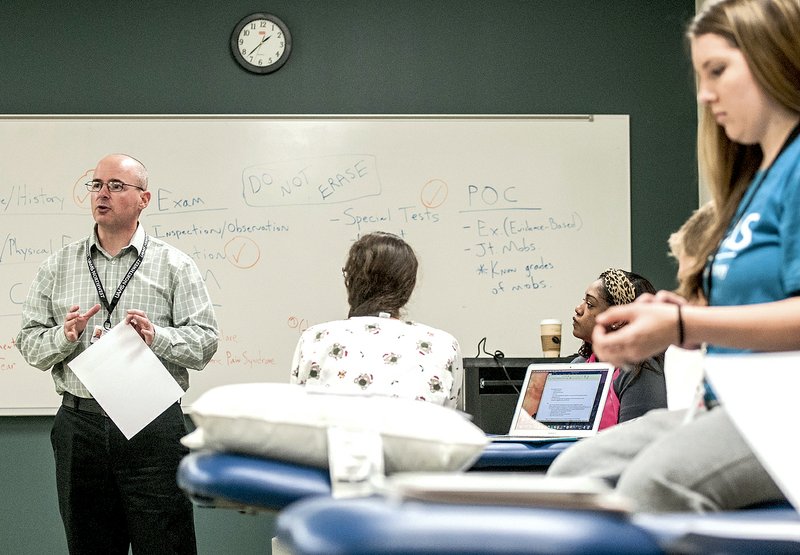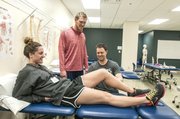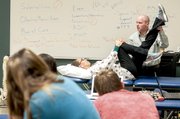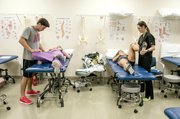Gracie Frizzell waited on her stomach on the padded bench. Dr. John Jefferson held her ankle and raised it, with the leg bending at the knee.
Around the room, about 20 observers watched from their perches on other benches or gathered around Jefferson and Frizzell.
"That's another way you can check for a torn ACL -- from behind," Jefferson explained to students in the physical therapy program at the University of Arkansas for Medical Sciences in Fayetteville. "It's called a Lachman test. You can test for an ACL tear by how much movement you get. There are five different ways to do this movement."
Next door, a group of students worked together, taking each others' "vitals" -- blood pressure, pulse rate, etc.
Along with the students, the physical therapy program in Fayetteville started its second semester Monday.
YEAR ONE
A designated donation to the University of Arkansas for Medical Sciences put the physical therapy program in Fayetteville, said Dr. Angel Holland, director of clinical education for the program. Jefferson is the director of the program. "This is the first full medical program UAMS offers outside of Little Rock," Holland said.
Twenty-four students were accepted for the first class of the nearly three-year program of study, with each graduate working toward a doctorate of physical therapy degree. The Fayetteville program is on track in the years-long accreditation process by the Commission on Accreditation in Physical Therapy, Holland said.
And, Holland said, this physical therapy training program is unique among others across the country. The founding directors studied programs at other physical therapy schools and tweaked them for what they thought would work here.
"The students are integrated into the clinic every Tuesday morning," Holland said. "It's a very early clinical arm (for physical therapy programs). They can take what they've learned in the classroom to real time in the first year.
"We are always using the example of having them apply their knowledge, seeing what the teaching really means," she continued.
Students begin working with patients in clinical settings during the first week of study. They join physical therapists as they meet patients in the UAMS Outpatient Therapy Clinic in Fayetteville. Students observe procedures and maybe perform a few of their own. And, sometimes, the physical therapists bring patient volunteers to the student lab for students to practice procedures, Holland said.
"(Students) can expect to be with patients in the first week," Holland said. "Typical programs, they don't see patients until year two. The doctors designed the program -- called integrated clinical experience or ICE -- to try to help students be able to apply the knowledge learned in class."
"You learn information (in class and labs), and then you see it put together when you work with patients. Then you perform it on a patient for a grade," said Kyle Roliard, a student originally from Houston.
"In the rotations, you make connections to what you're learning," said student Scott Van Kamp of Rogers. "You also get to see how other therapists interact with patients, their rapport."
The UAMS faculty let the therapists know what the students learned the week before in class, so students can check their understanding and see that information applied. Frizzell said the students learned in the first semester to assess a patient's gait, active and passive range of motion and more.
ICE rotations also include time with pediatric patients and residents of a skilled nursing facility .
"(The students seem) to be a treat with the patients next door (at the Veterans Administration home)," Holland said. "And the therapists are also responding positively -- they've seen growth."
By the time students finish their training in Fayetteville, they will have three years of experience working with patients, Holland said. Plus, students work full time in area physical therapy clinics during summers.
Working directly with physical therapists is another unique aspect of the local program, Holland said.
"Class time and lab time have been flipped," Roliard noted. "Students spend more time hands-on in the lab -- not always just sitting and listening to a lecture."
Lectures are recorded, and students can watch online on their own time, he continued. "And if you have questions, you can go right to practice in the lab."
"We ask a lot of questions," Frizzell said. "We bounce a lot of ideas off each other."
Even the classroom is unique. Student desks sit on individual platforms with wheels, allowing students to move together for group work. Roliard also appreciates the small class size.
The physical therapy school, located in the basement of the old Washington Regional Medical Center, also includes an exercise lab with treadmills, weights and a metabolic cart, so the students can see how the heart and lungs respond to exercise. A large mirror identifies the neurological lab, where students practice procedures for working with patients with cerebral palsy, Parkinson's disease or recovering from a stroke. And in the cadaver lab, students can see the tendons that react to ankle stress, the structures used in leg gait training and even what's behind the knee cap.
In addition to the skills labs, the physical therapy school houses a full medical library and participates in inter-library loan programs, Holland said.
At graduation, these now first-year students will be experts in their chosen fields, Holland said. Physical therapy includes eight specialty areas, according to the American Board of Physical Therapy Specialists -- cardiovascular and pulmonary, clinical electrophysiology, geriatrics, neurology, orthopaedics, pediatrics, sports and women's health -- and students in Fayetteville receive training in all, Holland said.
Throughout their training, students also will work with specialists from other areas -- occupational therapists, nurses, doctors. "They all are a part of the full health care team for the patient," Holland noted.
DRIVEN
Prior to enrolling in the UAMS physical therapy program, Frizzell found herself on an exam table -- twice, with back-to-back tears of an anterior cruciate ligament or ACL.
She was a member of the Ole Miss ladies basketball team -- much to her Razorback-loving, Little Rock family's dismay, she noted. But, in fact, she led the team in three-point shots during each year of play, Holland said.
Doctors released Frizell and gave their blessing for her to return to the team, but she gave up her final year of eligibility to begin her quest to become a physical therapist.
"Our first group of students is very driven," Holland said. "They are risk takers. They were very successful in other areas before they chose physical therapy."
Roliard was a pitcher in the Colorado Rockies organization when an injury led to his release from the team.
"I saw how beneficial physical therapy was to my own recovery," he said. "I thought, 'When baseball ends ...' From my experience with injury, I knew I wanted something in the medical field."
Van Kamp changed careers mid-stream, from restaurant management. He is the oldest student, at 38, Holland noted.
"We are pioneers of the program," Van Kamp said. "I was sold the first time I met Dr. Jefferson. His enthusiastic attitude sold me on the program."
"It's not easy," Frizzell said. "I've learned probably more this semester than in four years of undergrad."
"Undergrad was pretty much baby sitting," Van Kamp added. "This opens your eyes more to the real world. The professors in the program expect us to be professionals, to meet deadlines. You have to work on your time management skills, learn when to work and when to play."
In addition to classes, labs, clinics and coursework, each student is required to complete 10 hours of volunteer work each semester, whether related to physical therapy or not.
"It's not about what you do. It's about what you do with others," Holland said.
Students spend at least eight hours a day at the school -- and then some, Holland continued. "This is a full-time job. It's more than a job."
"It's rewarding to work with patients -- in general, to help people," Van Kamp said. "You get to see people get better."
Frizzell probably will always remember her first ICE rotation and a stroke patient, she said. The woman could not move the arm or leg on her left side, but by the time the four-week clinical rotation was over, the woman was almost walking, the student reported.
Frizzell concluded with tears in her eyes and a crack in her voice. "I really believe this is what I'm supposed to be doing."
NAN Our Town on 01/14/2016



